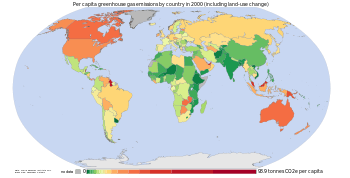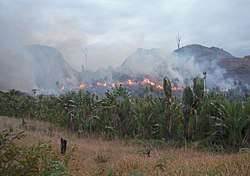Land use, land-use change, and forestry
Land use, land-use change, and forestry (LULUCF), also referred to as Forestry and other land use (FOLU), is defined by the United Nations Climate Change Secretariat as a "greenhouse gas inventory sector that covers emissions and removals of greenhouse gases resulting from direct human-induced land use such as settlements and commercial uses, land-use change, and forestry activities."[1]
LULUCF has impacts on the global carbon cycle and as such, these activities can add or remove carbon dioxide (or, more generally, carbon) from the atmosphere, influencing climate.[2] LULUCF has been the subject of two major reports by the Intergovernmental Panel on Climate Change (IPCC). Additionally, land use is of critical importance for biodiversity.[3]
Climatic impacts of land-use, land-use change, and forestry

Land-use change can be a factor in CO2 (carbon dioxide) atmospheric concentration, and is thus a contributor to global climate change.[4] IPCC estimates that land-use change (e.g. conversion of forest into agricultural land) contributes a net 1.6 ± 0.8 Gt carbon per year to the atmosphere. For comparison, the major source of CO2, namely emissions from fossil fuel combustion and cement production, amount to 6.3 ± 0.6 Gt carbon per year.[5]
This decision sets out the rules that govern how Kyoto Parties with emission reduction commitments (so-called Annex 1 Parties) account for changes in carbon stocks in land use, land-use change and forestry.[6] It is mandatory for Annex 1 Parties to account for changes in carbons stocks resulting from deforestation, reforestation and afforestation (B Article 3.3)[7] and voluntary to account for emissions from forest management, cropland management, grazing land management and revegetation (B. Article 3.4).[6]
The land use sector is critical to achieving the aim of the Paris Agreement to limit global warming to 2 °C (3.6 °F).[8]
The impact of land-use change on the climate is also more and more recognized by the climate modeling community. On regional or local scales, the impact of LUC can be assess by Regional climate models (RCMs). This is however difficult, particularly for variables, which are inherently noisy, such as precipitation. For this reason, it is suggested to conduct RCM ensemble simulations.[9]
Land use and biodiversity
The extent, and type of land use directly affects wildlife habitat and thereby impacts local and global biodiversity. [10] Human alteration of landscapes from natural vegetation (e.g. wilderness) to any other use can result in habitat loss, degradation, and fragmentation, all of which can have devastating effects on biodiversity.[11] Land conversion is the single greatest cause of extinction of terrestrial species.[12] An example of land conversion being a chief cause of the critically endangered status of a carnivore is the reduction in habitat for the African wild dog, Lycaon pictus.[13]
Deforestation is also the reason for loss of a natural habitat, with large numbers of trees being cut down for residential and commercial use. Urban growth has become a problem for forests and agriculture, the expansion of structures prevents natural resources from producing in their environment.[14] In order to prevent the loss of wildlife the forests must maintain a stable climate and the land must remain unaffected by development. Furthermore, forests can be sustained by different forest management techniques such as reforestation and preservation. Reforestation is a reactive approach designed to replant trees that were previously logged within the forest boundary in attempts to re-stabilize this ecosystem. Preservation on the other hand is a proactive idea that promotes the concept of leaving the forest as is, without using this area for its ecosystem goods and services.[15] Both of these methods to mitigate deforestation are being used throughout the world.
The U.S. Forest service predicts that urban and developing terrain in the U.S. will expand by 41 percent in the year 2060.[16] These conditions cause displacement for the wildlife and limited resources for the environment to maintain a sustainable balance.[17]
Forest Modeling
Traditionally, earth system modeling has been used to analyze forests for climate projections. However, in recent years there has been a shift away from this modeling towards more of mitigation and adaptation projections.[18] These projections can give researchers a better understanding of how to what future forest management practices should be employed. Furthermore, this new approach to modeling also allows for land management practices to be analyzed in the model. Such land management practices can be: forest harvest, tree species selection, grazing, and crop harvest. These land management practices are implemented to understand their biophysical and biogeochemical effects on the forest. However, there is a major lack of available data for these practices currently, so there needs to be further monitoring and data collecting to help improve the accuracy of the models.
See also
- Deforestation and climate change
- Land use
- Satoyama
- Special Report on Climate Change and Land
References
- "Glossary of climate change acronyms and terms". UNFCCC. Retrieved 2020-04-06.
- Land use and the carbon cycle : advances in integrated science, management, and policy. Brown, Daniel G. Cambridge: Cambridge University Press. 2013. ISBN 978-1-139-62507-4. OCLC 823505307.CS1 maint: others (link)
- Towards Sustainable Land Use: Aligning Biodiversity, Climate and Food Policies. (2020). France: OECD Publishing.
- Ochoa-Hueso, R; Delgado-Baquerizo, M; King, PTA; Benham, M; Arca, V; Power, SA (February 2019). "Ecosystem type and resource quality are more important than global change drivers in regulating early stages of litter decomposition". Soil Biology and Biochemistry. 129: 144–152. doi:10.1016/j.soilbio.2018.11.009.
- "IPCC Special Reports: Land Use, Land-Use Change and Forestry". ipcc.ch. Retrieved 2017-09-02.
- "Reporting on LULUCF activities under the Kyoto Protocol". unfccc.int. Retrieved 2020-04-22.
- "Microsoft Word - kpcmp8a3.doc" (PDF). Retrieved 2010-04-29.
- "Land use and forestry regulation for 2021-2030". Climate Action - European Commission. 2016-11-23. Retrieved 2020-04-06.
- Laux, Patrick (2016). "How many RCM ensemble members provide confidence in the impact of land-use land cover change?" (PDF). International Journal of Climatology. 37 (4): 2080–2100. doi:10.1002/joc.4836.
- Landscape ecology and wildlife habitat evaluation : critical information for ecological risk assessment, land-use management activities, and biodiversity enhancement. Kapustka, Lawrence. West Conshohocken, PA: ASTM International. 2004. ISBN 0-8031-3476-2. OCLC 55488045.CS1 maint: others (link)
- Habitat loss : causes, impacts on biodiversity and reduction strategies. Devore, Bronson. New York: Nova. 2014. ISBN 978-1-63117-231-1. OCLC 867765925.CS1 maint: others (link)
- Bierregaard, Richard; Claude Gascon; Thomas E. Lovejoy; Rita Mesquita, eds. (2001). Lessons from Amazonia: The Ecology and Conservation of a Fragmented Forest. ISBN 0-300-08483-8.
- C. Michael Hogan. 2009. Painted Hunting Dog: Lycaon pictus, GlobalTwitcher.com, ed. N. Stromberg Archived 2010-12-09 at the Wayback Machine
- Ehrhardt-Martinez, Karen (Aug 16, 2003). "Demographics, Democracy, Development, Disparity and Deforestation: A Crossnational Assessment of the Social Causes of Deforestation". American Sociological Association. Archived from the original on 2008-12-10.
- Lund, H. Gyde (2006). Definitions of Forest, Deforestation, Afforestation, and Reforestation. Gainesville, VA: Forest Information Services.
- "Forest Service report forecasts natural resource management trends and challenges for next 50 years | US Forest Service". www.fs.usda.gov. Retrieved 2020-04-22.
- National Conference of State Legislature."State Forest Carbon Incentives and Policies".Jocelyn Durkay and Jennifer Schultz..22 March 2016. Web.25 April 2015.http://www.ncsl.org/research/environment-and-natural-resources/state-forest-carbon-incentives-and-policies.aspx
- National Research Council (U.S.). Committee on a National Strategy for Advancing Climate Modeling. (2012). A national strategy for advancing climate modeling. National Research Council (U.S.). Board on Atmospheric Sciences and Climate., National Research Council (U.S.). Division on Earth and Life Studies. Washington, D.C.: National Academies Press. ISBN 978-0-309-25978-1. OCLC 824780474.
